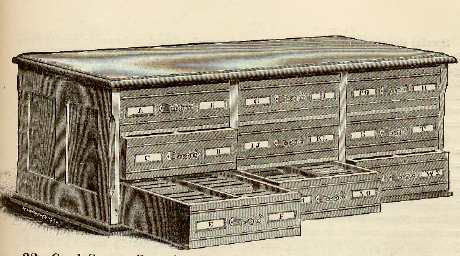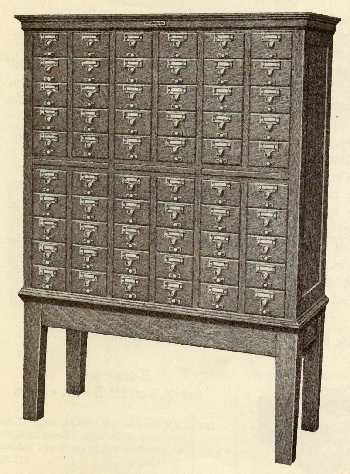The
Library History Buff
Promoting the appreciation, enjoyment, and preservation of library history
Evolution of the Library Card Catalog
November 1789
The revolutionary government of France
confiscates the library holdings of all religious houses. It is decided to
use the books to establish a system of public libraries. An inventory and
listing of all books is ordered. To accomplish this a set of instructions
is created which is known as the "French Cataloging Code of 1791".
Inventory takers use the blank backs of playing cards to write down the
bibliographic information for each book.
1840-1912
Harvard College Librarian Thaddeus William Harris urges in his
1840 annual report that a "slip catalogue" be created consisting of the title of
every work in the library on pieces of card 6 1/2 inches long and 1 1/2 inches
wide. According to library historian Kenneth E. Carpenter, this is
apparently the first reference to a card catalog in an American library. A
"slip catalogue" began soon after and continued to be used by staff of the
Harvard College Library until 1912. Cards in the Harris catalog actually
ended up being 9 inches long. Carpenter notes that the idea of a "slip
catalogue" probably originated with William Croswell who was hired by Harvard to
produce a new printed catalog in 1812. Croswell began his task by cutting up the
printed catalog of 1790 into slips.
September 16, 1853
At the Library Conference of 1853, Charles
Folsom, librarian of the Boston Athenaeum, describes his card catalog. It
"consisted of a series of cards, about nine inches long and two wide, which were
laid in a pile and a hole bored through each end of the whole, and strings
passed through them. These strings were of such a length as to allow the
whole of the cards to be slid back or forward, as the writer or compositor
should find necessary, yet still preserving them in their proper order, without
confusion or danger of loss. The whole were fitted into a box of the
requisite size, from which they could be drawn singly without deranging the
consecutiveness of each."
1860-1863
In 1860 Harvard Librarian John Langdon
Sibley proposes a card catalog for public use as a method of keeping the
library's catalog up to date. Assistant Librarian Ezra Abbot takes on the
task of designing a card catalog that could be easily accessed but was secure
from getting out of order. This involved placing the cards on edge between
two wooden blocks. His solutions are described in the Annual Report of the
library for 1863 and were adopted by many American libraries. Work on the
catalog began in 1862 and hand written cards for 35,762 books were created in
the first year. The catalog cards were 5 x 12.25 cm (2 x 5 inches) inches
wide and two inches high. Although some variations of the card catalog existed
in American libraries as early as the 1840s, those catalogs were primarily for
staff use. The Harvard catalog was the first created for public use. For
more on the catalog cards used by Harvard click
here.
 This
12 tray Library Bureau
card catalog belongs to Norman D.
Stevens who provided the following information. "According to the
U. S. patent information on the blocks that hold the cards in place it was
manufactured after May 1903. This cabinet is 13¾” wide, by 15½” deep, by 19¼”
high; it holds Harvard College size cards (2” x 5”) that were one of the two
standard sizes adopted at the first American Library Association conference in
1877. It was formerly used at the Middlebury College Library in Middlebury, VT.
Although more compact than trays holding cards of the other standard (3” x 5”),
these smaller catalogs were largely abandoned by 1925. That was probably due to
the fact that when the catalog cards in it were tightly packed it was difficult
to read text toward the bottom of the card."
This
12 tray Library Bureau
card catalog belongs to Norman D.
Stevens who provided the following information. "According to the
U. S. patent information on the blocks that hold the cards in place it was
manufactured after May 1903. This cabinet is 13¾” wide, by 15½” deep, by 19¼”
high; it holds Harvard College size cards (2” x 5”) that were one of the two
standard sizes adopted at the first American Library Association conference in
1877. It was formerly used at the Middlebury College Library in Middlebury, VT.
Although more compact than trays holding cards of the other standard (3” x 5”),
these smaller catalogs were largely abandoned by 1925. That was probably due to
the fact that when the catalog cards in it were tightly packed it was difficult
to read text toward the bottom of the card."
April 30, 1877
A preliminary report of the Cooperation
Committee of the American Library Association is published in the American
Library Journal (now the Library Journal). The report makes
recommendations for standard catalog cards in two sizes. One size is the
Harvard College size of 5 x 12.25 cm and the other is the "postal" size of 7.5 x
12.25 cm. The second size was to become the predominant choice for
American library catalog cards. The two standards were officially adopted
at the first conference of the American Library Association which took place in
New York on September 4-5, 1877. Although Melvil Dewey wasn't actually a
member of the Cooperation Committee, as Secretary of ALA he was actively
involved in its deliberations and was largely responsible for the adoption of
the standards.
1886
Both catalog card stock and card catalog
cabinets were marketed by Library Bureau, the library supply company founded by
Melvil Dewey. The company was legally established in 1881although its
predecessors date back to 1876. By 1886 the Library Bureau had an
extensive line of products related to card catalogs. Many of these items were
illustrated in its 1886
library supply catalog including the early card catalog cabinet
below.

The catalog cabinet is designed to hold
standard 7.5 x 12.5 cm catalog cards but unlike later catalog cabinets each
drawer is divided into two rows.
1893
In a paper presented at the World's Library
Congress held at the Columbian Exposition, William C. Lane, Librarian of the of
the Boston Athenaeum, provided an overview of current cataloguing practices of
American libraries.
Form of the catalog in use by libraries:
printed catalog with printed supplements; printed catalog with card supplements;
on cards complete; on slips pasted in volumes; on slips fastened in bunches like
the leaves of a book; the Rudolph
Indexer; printed finding lists or
other abbreviated form; and printed bulletins of recent accessions.
Catalog cases: "Until recently the
usual custom has been to keep the cards of the catalog in drawers each drawer
having ordinarily two rows of cards." (See above). "... a lighter drawer or
sliding sliding tray has lately been introduced holding a single row of cards
and often not as deep as the old drawers."
Catalog card sizes: "There are two
recognized standards sizes in common use, the so called postal size, 12.5x7.5
cm. and the smaller size, 12.5.5 cm." Other sizes in use: 12.75x5.2 cm.;
12.75x7.25 cm.; 6x4 in.; 12.8x5 cm.; 13.85x8 cm.; 13.35x5.05 cm.; 13x5.7 cm;
15.5x8 cm.; 14x7 cm.; and 5x2&5/8 in.
Writing and printing methods for catalog
cards: "Most libraries still employ a running hand, generally preferring an
upright and round letter to a slanted or angular." The typewriter is
employed by some libraries. The
Hammond machine is used by most of these
although some use the Remington. "Printed cards are now supplied by the
Library Bureau at a moderate price for current new books, while some libraries
print their own cards or mount printed slips on cards for their card catalog."
1901
The Library of Congress begins the sale and
distribution of pre-printed catalog cards to libraries throughout the nation.
1925
By 1925 the American library card catalog
had substantially evolved and standardized catalog cards (7.5 x 12.5 cm) in
standardized card catalog cabinets were in widespread use. The card
catalog cabinet illustrated below is from a 1925 Library Bureau supply catalog.

Click
here for information on the current use of
old card catalog cabinets.
Sources:
"A History of the Card Catalog" by Sandy
Brooks in Whole Library Handbook 3 compiled by George M. Eberhart.
American Library Association 2000.
The First 350 Years of the Harvard
University Library by Kenneth F. Carpenter. Harvard University Library 1986.
Irrepressible Reformer by Wayne A.
Wiegand. American Library Association 1996.Mitchell,
Barbara A. "Boston Library Catalogues,
1850-1875 Female Labor and Technological Change," in Augst and Carpenter, eds.
Institutions of Reading: The Social Life of Libraries in the United States
(University of Massachusetts Press, 2007), pp. 119-147.
Papers Prepared for the World's Library
Congress Held at the Columbian Exposition edited by Melvil Dewey. Government
Printing Office 1896.
This site created and maintained
by
Larry T. Nix
Send comments or questions to
nix@libraryhistorybuff.org
Last updated: 01-21-09
© 2005-2008 Larry T. Nix
Also check out the
Library History Buff Blog.
 This
12 tray Library Bureau
card catalog belongs to Norman D.
Stevens who provided the following information. "According to the
U. S. patent information on the blocks that hold the cards in place it was
manufactured after May 1903. This cabinet is 13¾” wide, by 15½” deep, by 19¼”
high; it holds Harvard College size cards (2” x 5”) that were one of the two
standard sizes adopted at the first American Library Association conference in
1877. It was formerly used at the Middlebury College Library in Middlebury, VT.
Although more compact than trays holding cards of the other standard (3” x 5”),
these smaller catalogs were largely abandoned by 1925. That was probably due to
the fact that when the catalog cards in it were tightly packed it was difficult
to read text toward the bottom of the card."
This
12 tray Library Bureau
card catalog belongs to Norman D.
Stevens who provided the following information. "According to the
U. S. patent information on the blocks that hold the cards in place it was
manufactured after May 1903. This cabinet is 13¾” wide, by 15½” deep, by 19¼”
high; it holds Harvard College size cards (2” x 5”) that were one of the two
standard sizes adopted at the first American Library Association conference in
1877. It was formerly used at the Middlebury College Library in Middlebury, VT.
Although more compact than trays holding cards of the other standard (3” x 5”),
these smaller catalogs were largely abandoned by 1925. That was probably due to
the fact that when the catalog cards in it were tightly packed it was difficult
to read text toward the bottom of the card."
